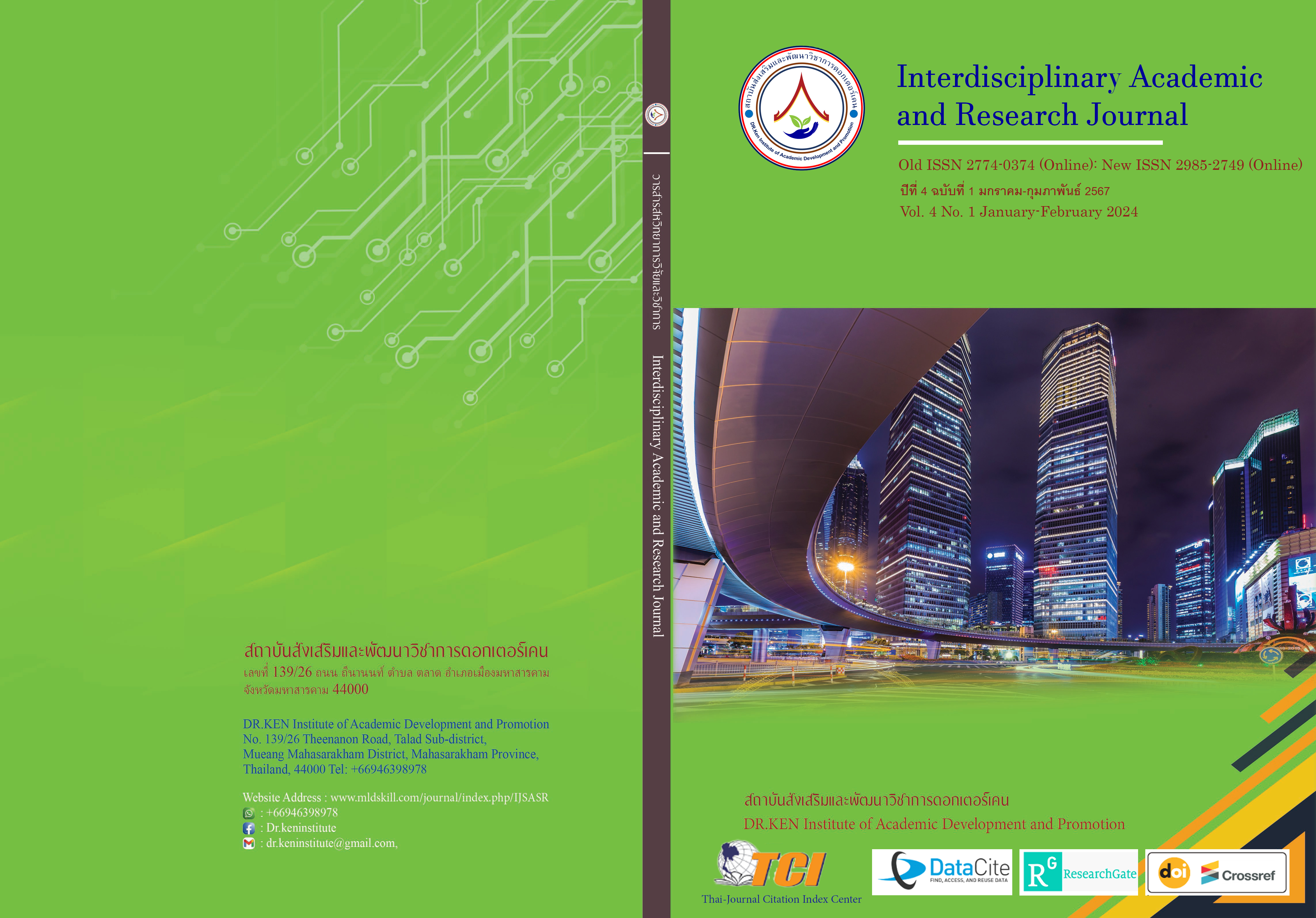Community Involvement in Developing the Village of Nong Sarai, Phanom Thuan District, Kanchanaburi Province, in accordance with the Philosophy of Sufficiency Economy
DOI:
https://doi.org/10.60027/iarj.2024.273239Keywords:
Development; , Participation; , Community; , Resource; , Rhythmic Pacing StudentAbstract
Background and Aims: The sufficiency economy, is a philosophy that points out the way of living and behaving for people at every level, from the family level, community level, to the state level. Both in developing and managing the country in the middle way. Especially economic development to keep up with the globalization world. Thus, this research aims; (1) To study community development according to the philosophy of Sufficiency Economy. (2) To study participation in community development according to the philosophy of Sufficiency Economy in Ban Nong Sarai community, Phanom Thuan District, Kanchanaburi Province. And (3) To use the information obtained as a model for community development according to the philosophy of Sufficiency Economy in the Ban Nong Sarai community, Phanom Thuan District, Kanchanaburi Province to other areas.
Methodology: This research is a survey research type. The population is 3,651 people living in the Ban Nong Sarai community. The sample group consisted of 351 people in the Ban Nong Sarai community. Data were collected from a sample group by visiting the area using a random questionnaire. Data were analyzed by distributing frequencies and finding percentages and standard deviations.
Results: (1) Studying community development according to the Sufficiency Economy Philosophy of the people in the Ban Nong Sarai community tends to develop in a better direction as measured by community development and award-winning works. (2) Participation in community development according to the philosophy of Sufficiency Economy in the community is at the highest level of participation, that is, people cooperate in decision-making and expressing opinions about operations to develop their own community. And (3) The results of using the information obtained as a model for community development according to the philosophy of Sufficiency Economy in the community allow other communities to study and learn and be a model for their own community development.
Conclusion: A study in the Ban Nong Sarai community found that They are most involved in decision-making, operations, and benefits. According to the philosophy of Sufficiency Economy, this participation is a model for community development. The people cooperate in making decisions and carrying out work for development. Using the information as a model in the Ban Nong Sarai community allows other communities to study, learn, and develop themselves.
References
กรมพัฒนาชุมชน. (2560). ปรัชญาการพัฒนาชุมชน. Retrieved on July 1, 2023, from: https://www.cdd.go.th/contact-us/related-divisions-website-cdd.
กิตติพงษ์ พลทิพย์. (2561). การศึกษาแหล่งเรียนรู้ด้วยตนเองในรายวิชาศิลปะการดำเนินชีวิตตามหลักเศรษฐกิจพอเพียง. สาขาวิชาเศรษฐศาสตร์ธุรกิจ. คณะวิทยาการจัดการ, มหาวิทยาลัยราชภัฏมหาสารคาม.
กีรติวรรณ กัลยาณมิตร. (2563). การมีส่วนร่วมของชุมชนในการพัฒนาหมู่บ้านเศรษฐกิจพอเพียง:กรณีศึกษาชุมชนตำบลหัวดง อำเภอเมือง จังหวัดพิจิตร, วารสารรัชต์ภาคย์, 14(34), 70-78.
ชุมชนพอเพียงบ้านหนองสาหร่าย. (2565). ศูนย์การเรียนรู้เศรษฐกิจพอเพียงบ้านหนองทราย ตำบลหนองสาหร่าย จังหวัดกาญจนบุรี. Retrieved on July 10, 2023, from: http://ebook.nfe.go.th/nfe_ebook/data_ebook/7/1_121_130.pdf.
เทศบาลตำบลหนองสาหร่าย. (2566). ข้อมูลพื้นฐานสภาพทั่วไปของหมู่บ้าน. Retrieved on July 10, 2023, from: http://www.nongsarai.go.th/site/index.php?option49.
ธวัช พุ่มดารา. (2560). การมีส่วนร่วมในการพัฒนาชุมชนตามแนวทางปรัชญาเศรษฐกิจพอเพียงของเทศบาลคลองโยง อำเภอพุทธมณฑล จังหวัดนครปฐม. หลักสูตรรัฐประศาสนศาสตรมหาบัณฑิต. สาขาวิชานโยบายสาธารณะ, มหาวิทยาลัยนเรศวร.
ธัญญาลักษณ์ ใจเที่ยง. (2563). การมีส่วนร่วมของชุมชนในการจัดการเขตอนุรักษ์สัตว์น้ำ: กรณีศึกษา หมู่ที่ 1 ตำบลป่าขาด อำเภอสิงหนคร จังหวัดสงขลา. หลักสูตรปริญญาวิทยาศาสตรมหาบัญฑิต. สาขาวิชาการจัดการสิ่งแวดล้อม, มหาวิทยาลัยสงขลานครินทร์.
พระธวัชชัย สนติธมโม วรรณนาวิน. (2561). การมีส่วนร่วมของประชาชนในการพัฒนาชุมชนในเขต เทศบาลเมืองสระแก้ว, ปริญญารัฐศาสตรมหาบัณฑิต. คณะรัฐศาสตร์, มหาวิทยาลัยมหาจุฬาลงกรณราชวิทยาลัย.
ศรีนวล แตงภู่และคณะ. (2561). การมีส่วนร่วมของประชาชนในการพัฒนาหมู่บ้านเศรษฐกิจพอเพียงต้นแบบชุมชนบ้านร่องหมากน้อย ตำบลกลันทา อำเภอเมือง จังหวัดบุรีรัมย์. วารสารบัณฑิตศาส์น, 16(1), 257–258.
ศาลิมาร์ เกิดกลิ่นหอม และณพงศ์ นพเกตุ. (2562) แนวทางการมีส่วนร่วมของประชาชนในการจัดการขยะมูลฝอยในเขตเทศบาลนครนครศรีธรรมราช, วารสารการจัดการสิ่งแวดล้อม, 16(2), 61-73.
สำนักงานคณะกรรมการพัฒนาการเศรษฐกิจและสังคมแห่งชาติ. (2560). ปรัชญาเศรษฐกิจพอเพียงและการประยุกต์ใช้. Retrieved on July 8, 2023, from http://social.nesdc.go.th/social/sep/Book/2560/sufficiency.pdf.
สำนักงานคณะกรรมการพัฒนาการเศรษฐกิจและสังคมแห่งชาติ. (2560). แผนพัฒนาเศรษฐกิจและสังคมแห่งชาติ ฉบับที่สิบสอง. Retrieved on 1 July 2023 from: https://www.nesdc.go.th /ewt_dl_link.php?nid=6422.
สุธาวี กลิ่นอุบล. (2562). การศึกษาการมีส่วนร่วมของชุมชนต่อความสำเร็จในการพัฒนาชุมชนตามแนวทางปรัชญาเศรษฐกิจพอเพียง บ้านห้วยเขาจีน ต.ห้วยยางโทน อำเภอปากท่อ จังหวัดราชบุรี. หลักสูตรศึกษาศาสตรมหาบัณฑิต. สาขาวิชาพัฒนศึกษา. มหาวิทยาลัยศิลปากร.
อัครินทร์ อังกูรวงษ์วัฒนา. (2562). การมีส่วนร่วมของประชาชนการมีส่วนร่วมหมู่บ้านเศรษฐกิจพอเพียงของชุมชนบ้านบางเบา อำเภอพุนพิน จังหวัดสุราษฎร์ธานี. วารสารนิติศาสตร์และสังคมท้องถิ่น, 3(2), 55-58.
อานนตรี ประสมสุข. (2561). การประยุกต์ใช้หลักปรัชญาเศรษฐกิจพอพียงตามหลักพระพุทธศาสนาของปราชญ์ชาวบ้าน ตำบลขาว อำเภอเสลภูมิ จังหวัดร้อยเอ็ด. วิทยานิพนธ์หลักสูตรปริญญาพุทธมหาบัณฑิต. สาขาวิชาพุทธศาสนา. มหาวิทยาลัยมหาจุฬาลงกรณราชวิทยาลัย.
Krejcie, R.V. & Morgan, D.W. (1970) Determining Sample Size for Research Activities. Educational and Psychological Measurement, 30, 607-610.
Downloads
Published
How to Cite
Issue
Section
License
Copyright (c) 2024 Ketkanok Khanami, Nattapat Thanarinrada, Nattaphat Chaum

This work is licensed under a Creative Commons Attribution-NonCommercial-NoDerivatives 4.0 International License.
Copyright on any article in the Interdisciplinary Academic and Research Journal is retained by the author(s) under the under the Creative Commons Attribution-NonCommercial-NoDerivatives 4.0 International License. Permission to use text, content, images, etc. of publication. Any user to read, download, copy, distribute, print, search, or link to the full texts of articles, crawl them for indexing, pass them as data to software, or use them for any other lawful purpose. But do not use it for commercial use or with the intent to benefit any business.
















.png)


